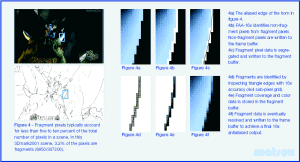With Fragment Antialiasing, rather then applying multiple samples to every pixel, regardless of whether or not the pixel requires extra samples, each pixel is tested to establish if a polygon edge occurs through it. Pixels that do not require any extra samples, i.e. those that occur fully within a polygon, are sent straight to the frame buffer with no extra samples and hence no extra bandwidth utilisation. Pixels that do span an edge, and hence require anti-aliasing, have the extra samples applied and are then sent to a separate 'fragment buffer' which stores lists of the pixels and their appropriate subsample information. Once all the pixels, and fragments, for the scene are written the fragment pixels are combined and written to the frame buffer ready for final display.
FAA has the advantage that it requires less fill-rate than other normal Super- or Multi-sample solutions, and potentially less bandwidth (in theory compressed Multisampling is probably likely to achieve similar bandwidth levels). Because of the reduced pixel and bandwidth requirements more samples for the pixels that require extra sampling can be done, in the case of Matrox's FAA they have opted for 16 samples which compares to the current Maximum of 6 samples on ATI's Radeon 9700 PRO's Multi-sample FSAA. However, a drawback of FAA is that there are some cases in which it does not apply extra samples where it probably should.
10-bit GigaColor - Parhelia uses 10-bit per channel throughout the pipeline, including the dual RAMDAC's. With 10-bits per channel colour output this increased the dynamic range of colours available from the 16 million of 24-bit output to over a billion colours. Matrox have enabled GigaColor to operate both for normal Windows desktop use or in 3D rendering as well.
The DVD playback also operates at 10-bit per channel precision.
Dual Head High Fidelity / Triple Head Desktop - Matrox's forte has always been with their multi-monitor outputs and Parhelia is no exception. Parhelia includes dual 400MHz RAMDAC's with dual DVI output's capable of displaying dual 2048 x 1536 at 32bpp analogue outputs or dual 1600 x 1200 at 32bpp digital outputs with hardware overlays, hardware cursors and gamma correction for video.
Parhelia also supports a Triple head stretched desktop mode that can utilise up to 3 display outputs and stretch the Windows desktop across them all. In this mode a maximum resolution of 3840 x 1024 at 32bpp is supported.
Surround Gaming - Extending triple head from the desktop, Matrox also takes it into gaming, hence 'Surround Gaming'. The extra screens give more rendering space, giving three times the field of view. Many games already released can support Surround Gaming and newer titles are being released with support already built in for it -- a list of titles supporting the feature can be found on Matrox's website here.


